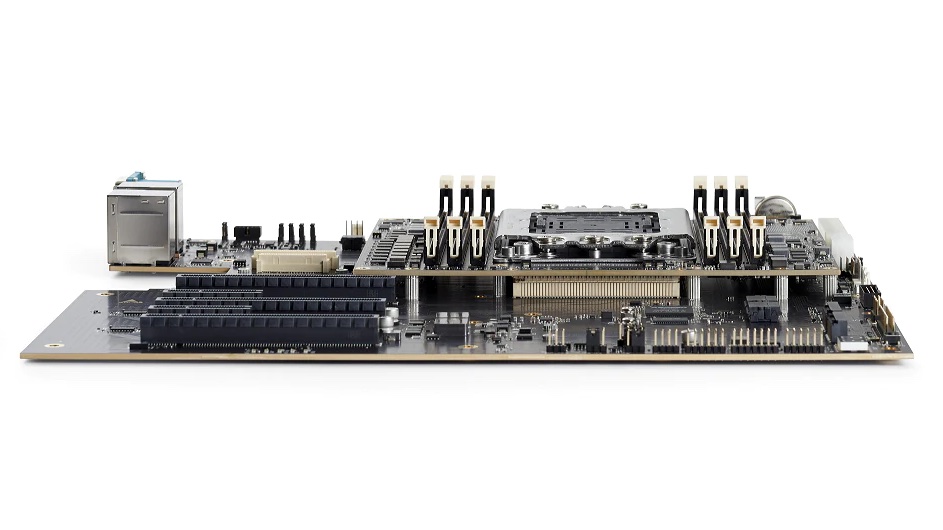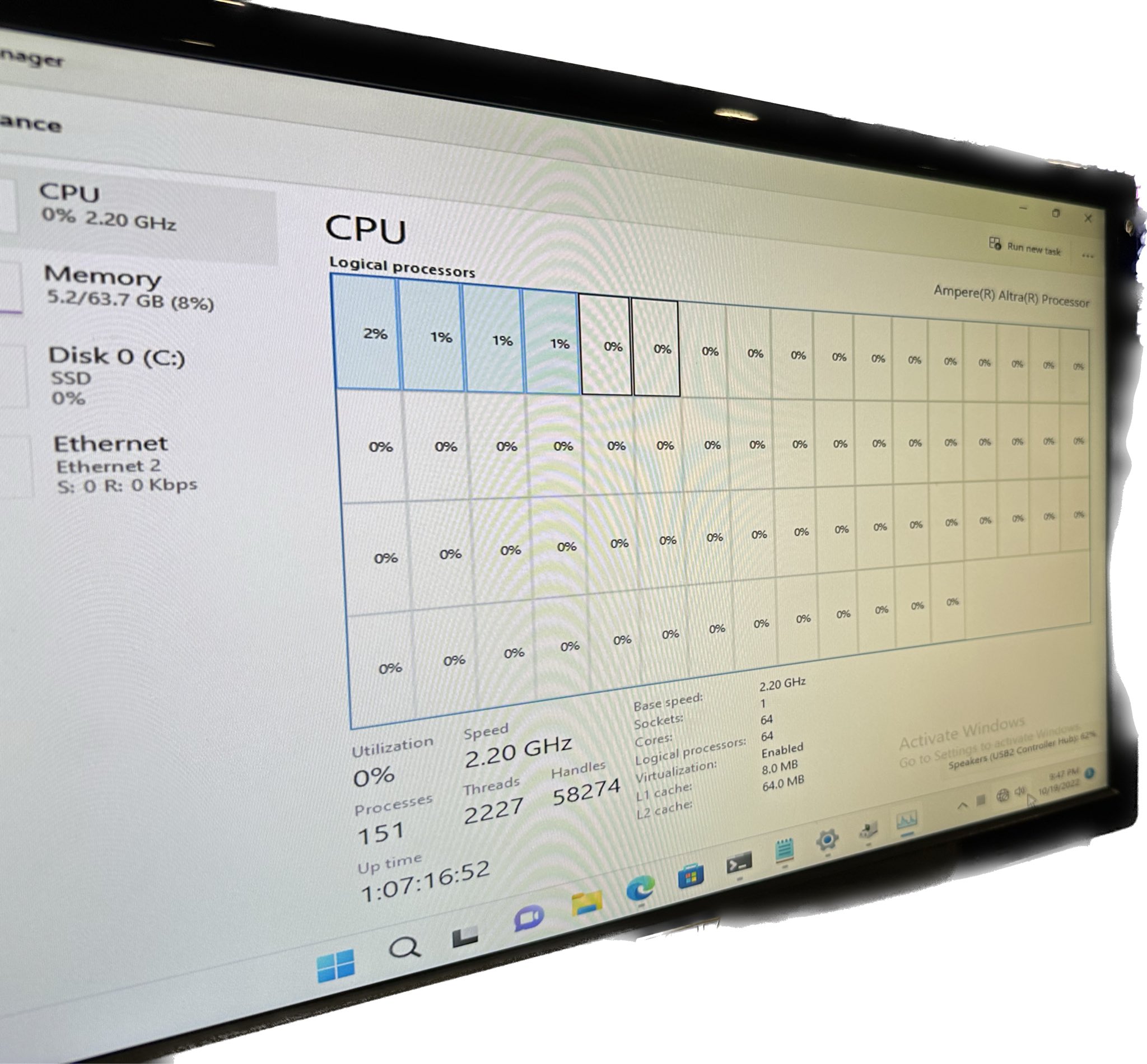Ampere's New 128-Core Arm Workstation Runs Windows
Ampere launches developers kits for cloud native app developers.
Ampere has quietly launched its Altra developers kit aimed at software creators for cloud data centers. Along with Dev Kit featuring the company's system-on-chips with up to 80 cores, the Ampere also offers a pre-built workstation running its 128-core SoC, according to Joe Speed, the company’s edge computing chief. An unexpected twist is that the workstation can run Windows and even has driver support for Nvidia's GeForce RTX graphics cards.
The Ampere Altra Developer Platform (AADP) is a prototyping system for general embedded applications, but it can obviously be used for building software for the cloud. The machine can use a variety of add-in boards, including Nvidia's GeForce RTX cards. What is a bit surprising is that it can run Windows, making it perhaps the most powerful Arm-based machine that runs the consumer-oriented Microsoft operating system.


Given AADP's Windows support, nothing stops software makers from trying to port their performance applications to high-performance multi-core Arm hardware and see what kind of performance they can get out of Ampere's SoC.
The AADP uses Ampere's Altra Dev Kit, which includes a COM-HPC module powered by an Arm Neoverse N1-based architecture. The module has 32/64/80 Arm v8.2 64-bit cores that operate at frequencies of up to 1.70 GHz, 2.20 GHz, and 2.60 GHz. The motherboard supports up to 768 GB of DR4 memory and fully exploits the I/O capabilities of Ampere's 128-core SoC, which offers three x16 and two x4 PCIe slots as well as a couple of M.2 slots for SSDs.

When it comes to supporting Nvidia's GeForce RTX consumer graphics cards, this is something unexpected as Ampere's SoCs are aimed primarily at cloud and edge computing applications, whereas Nvidia's GeForce RTX is designed primarily for gamers and content creators (when used with Studio drivers). Yet, the support does not come as completely unsurprised as, at the end of the day, Ampere and Nvidia work together on the data center front in general and the gaming data center part of it in particular.
Anyhow, for now, Ampere's AADP workstation is available for orders starting at $3,250 for a 32-core version with 32 GB of DDR4 and $5,658 for a 128-core version with 128 GB of memory. Meanwhile, the devkit itself starts at $2,003.
Get Tom's Hardware's best news and in-depth reviews, straight to your inbox.

Anton Shilov is a contributing writer at Tom’s Hardware. Over the past couple of decades, he has covered everything from CPUs and GPUs to supercomputers and from modern process technologies and latest fab tools to high-tech industry trends.
-
ezst036 It's nice to see that ATX board there. That's something that's been sorely missing from much of the ARM/RISC news and developments.Reply -
bit_user It might be slightly off the mark to attribute these to Ampere. They're by ADLINK, which is a large OEM of industrial computing systems. Their IPI business seems aimed specifically at the dev kit market. So, I'm not sure how much Ampere had to do with this.Reply
Overall, there's nothing new here. The CPUs are from their Altra line, launched back in 2020. You could already buy workstations featuring them for a couple years, if you didn't want to buy one of Gigabyte's servers or rent time on one of Google's Altra cloud instances.
As for Nvidia support, they've been supporting their GPUs on ARM for the past 5 years, at least. Not to say there's zero effort in making sure everything works on a new platform, but you'd pretty much expect it to work. To be fair, I guess I've never heard of Nvidia GPUs working under Windows on ARM - that's news to me!
Beyond that, the only other thing that's notable about these is the price, which is pretty decent and I think a lot less than I've seen other Altra workstations selling for. Then again, Altra is getting pretty long in the tooth, being based on ARM's A76 cores (in their Neoverse N1 incarnation). Single-thread performance leaves a lot to be desired, especially with the sub-3 GHz clockspeeds mentioned. -
bit_user Reply
The closest you're likely to see is if they get Windows running on one of the Jetson boards. The Orin AGX has rather respectable specs:atomicWAR said:I'd love Nvidia and others to start creating ARM mobo's for windows on the regular.
https://developer.nvidia.com/embedded/jetson-modules#jetson_agx_orin
Well... the CPU cores apparently only clock up to 2.2 GHz, so not that interesting. Still, 12x A78 cores is definitely closer to Desktop PC performance than it is to a Raspberry Pi.
What would be really nice is to have a carrier board that you could plug a 72-core Grace CPU into. Somehow, I don't see that happening. It wouldn't be cheap either. -
Spuwho NVidia owns 17% of Ampere. If NVidia had bought ARM they would have owned 38% of Ampere.Reply
Beware of these cheap "developer kits". They look enticing until you see that they almost always use technology that is at or near EOL.
Altra N1, DDR4 should be your first clue that some integrator is unloading inventory.
Microsoft did the same thing with their ARM developer kit. Before it died Marvell did the same with the ThunderX2. Qualcomm's was a joke. It's just an unload. -
atomicWAR Replybit_user said:The closest you're likely to see is if they get Windows running on one of the Jetson boards. The Orin AGX has rather respectable specs:
https://developer.nvidia.com/embedded/jetson-modules#jetson_agx_orin
Well... the CPU cores apparently only clock up to 2.2 GHz, so not that interesting. Still, 12x A78 cores is definitely closer to Desktop PC performance than it is to a Raspberry Pi.
What would be really nice is to have a carrier board that you could plug a 72-core Grace CPU into. Somehow, I don't see that happening. It wouldn't be cheap either.
I pondered playing with Nvidia boards for Windows but haven't as of yet. I tend to run a Windows based NAS (so it can run double duty as a back up rig/ remote renderer for video back-up, etc)...its in use cases like that I could see myself going arm. Where gaming is off the board, pun intended, and low power with good network/disk throughput is more important. It be more for fun at this point. I'll let you know if I ever dive head first and try it out. Thx as always for your reply!